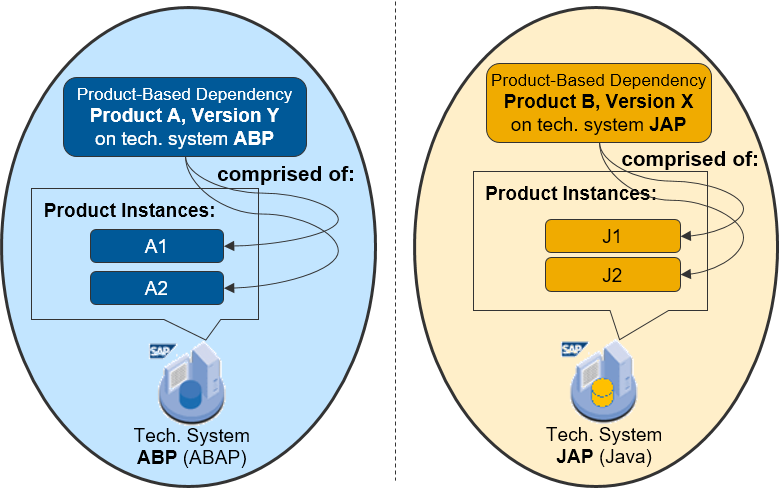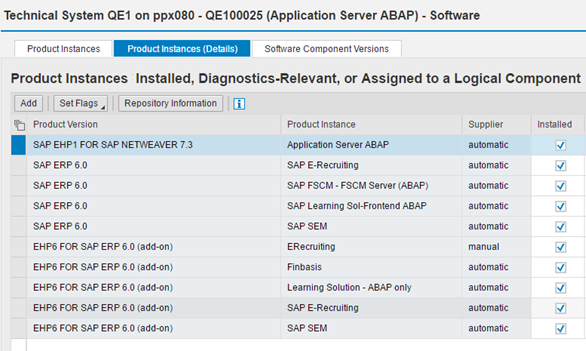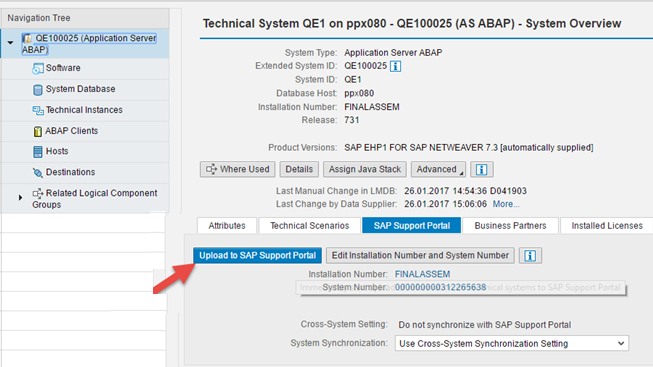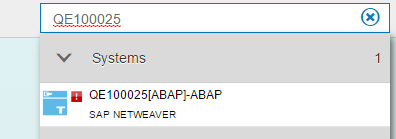
- SAP Community
- Products and Technology
- Technology
- Technology Blogs by SAP
- SAP Solution Manager: Special Cases in Installatio...
Technology Blogs by SAP
Learn how to extend and personalize SAP applications. Follow the SAP technology blog for insights into SAP BTP, ABAP, SAP Analytics Cloud, SAP HANA, and more.
Turn on suggestions
Auto-suggest helps you quickly narrow down your search results by suggesting possible matches as you type.
Showing results for
wolf_hengevoss
Active Participant
Options
- Subscribe to RSS Feed
- Mark as New
- Mark as Read
- Bookmark
- Subscribe
- Printer Friendly Page
- Report Inappropriate Content
02-24-2017
1:00 PM
1. Scope and Related Information
For SAP Solution Manager 7.1 SPS 05 and higher plus SAP Solution Manager 7.2
This guide deals with software scenarios that contain some exceptions from the rules. Nevertheless, they have a lot in common with the “normal” scenarios when it comes to tools and concepts. To understand these, read:
- Upgrade Information, Upgrade Tools and Application-Specific Information for installation of support package stacks, enhancement packages, and additional Java instances (technical units)
- Information on Landscape Management – the Process for a real-live example of the planning of an EHP update
- Documentation for System Landscape Management – LMDB for information on how to handle the LMDB
2. Introduction
This guide comprises recommendations on how to manage particular SAP products to which certain exceptions apply. The focus is on new installation, modeling of the product installation in the Landscape Management Database (LMDB) or the Maintenance Planner of SAP Solution Manager, and on updates or upgrades with the Maintenance Planner and Software Update Manager (SUM).
Most technical systems can automatically supply information about their installed software to an SLD, with an SLD data supplier (e.g. transaction RZ70 for AS ABAP). From an SLD, this technical system data is synchronized with the LMDB and from here, it is uploaded to the customer profile in the SAP Support Portal, which is read by the Maintenance Planner. For details, read Topology of SLD, LMDB, and Customer Profile – How to Get Reliable Landscape Data in SAP Support Port....
Based on this mere technical system information, you create logical landscape data in the LMDB, by defining product systems, or maintenance dependencies and technical scenarios, which semantically describe inter-dependencies between technical systems.
To address all technical systems used in one product installation, you need to describe product-based dependencies. This, you can do by either creating product systems in the LMDB or maintenance dependencies in the Maintenance Planner.
A product system or maintenance dependency describes how a product version’s product instances are installed on different technical systems, or on technical systems that constitute a dual-stack. All parts of a product system are maintained as one unit. So you must define the product system consistently with the product version information from the SAP Support Portal. The verification function in the LMDB editor for product systems helps you do so.
Product system descriptions define the software to be deployed in an update or upgrade of the product system. They enable Maintenance Optimizer to create a correct stack XML for that software download.
So product systems or maintenance dependencies define the scope of your maintenance projects for all involved technical systems.
Things would be simple if you could install any product version (SAP ERP or SAP CRM, for example) on a single technical system. But this is not possible because ...
- ...it would be inflexible installed software could not be reused. For example, you could not use one Enterprise Portal System for several business systems. Product system definitions describe dependencies and reuse between technical systems. This is required to be able to update the technical systems consistently and keep the solution running.
- ...it would require the installation of dual-stack systems, because even in product versions like SAP ERP 6.0, core parts based on AS ABAP are combined with AS Java-based parts, such as – most prominently – the Enterprise Portal used for Employee Self-Services in an HR scenario.
To enable reuse, often only certain parts of one product version are installed, and the installation is distributed over several technical systems. For more information, see the
White Paper: SAP Solution Landscape.
Note:
The Maintenance Optimizer has now been sunset – read more under https://blogs.sap.com/2017/01/06/maintenance-optimizer-sunset-in-sap-solution-manager-7.1/.
3. Standard Product-Based Dependencies
One installation of an SAP product version (e.g. SAP ERP 6.0 or SAP S/4HANA 1610) can be installed on 1 technical system or several technical systems. This is leading to product-based dependencies, called product system in the LMDB or maintenance dependency in the maintenance planner, helping you to address the whole installation. Therefore…
Examples are given in the following. For more background information, read Landscape Management - the Process:
- Product Systems and Maintenance Planner in SAP Solution Manager 7.1
- Landscape Entities & Maintenance Planner in SAP Solution Manager 7.2
Examples
Example 1: The Simplest Case – Single System
In the simplest case, one technical system with all its product instances is used in the product system.
The following example shows two simple examples for a modeling of the product installation – valid for product systems for different technologies, with one technical system each – note that for this simplest example no maintenance dependency is needed):

Figure 01: Two generic examples for a product-based dependency. These can vary even within the product version because of all product instances (grouping software component versions) of the product version that have been picked for the installation.
Example 2: Backend plus Front-End System
In a slightly more complex scenario, two technical systems with different technologies comprise one modeling of the installation (product system or maintenance dependency). For example, an SAP ERP 6.0 system that uses an SAP NetWeaver portal. The portal is a ‘sidecar’ technical system and is updated together with the ERP system; to achieve the same behavior for a maintenance dependency, the setting would be ‘maximum impact’:

Figure 02: Generic example for a product-based dependency of a product installation on two technical systems.
Note:
Here you will have to define a maintenance dependency.
One more remark: While product instances are used to define product systems and maintenance dependencies, for the latter you need not pick them manually.
Example 3: Reuse of 1 Front-End from Several Backend Systems
If the steps of the business processes are tightly integrated, there are dependencies between connected technical systems that must be considered in an upgrade. An example is an HR application of SAP ERP that runs on an AS ABAP-based backend system, and a separate SAP NetWeaver portal system that provides Employee Self-Services. The Portal system can also be reused, by an SAP CRM system for example. This reuse makes the technical system with the portal a ‘hub system’; in updates, it is updated to the minimum version required by the applications involved.
The graphic shows three product systems (HRP, CRP, and HRP), reusing a central hub technical system (EPP) with the Java Portal content. The hub is also modeled as a product system, to enable an independent update of the portal that is installed on it:

Figure 03: Example of the product-based dependency for SAP ERP 6.0 and SAP CRM 7.0 both making use of an SAP NetWeaver 7.0. This system is marked as a hub in SAP Solution Manager 7.0 or a system with minimum impact dependency in the Maintenance Planner. For more information, see the Planning Guide fitting your version.
Note:
Again: Here you will have to define a maintenance dependency.
One more remark: While product instances are used to define product systems and maintenance dependencies, for the latter you need not pick them manually to create a maintenance dependency.
4. Handling of Exceptional Products
The following sections describe examples of SAP products to which special installation and upgrade conditions apply.
4.1 Modeling of SAP SEM-BW, SAP ERECRUIT, LSOFE, and FINBASIS
SEM-BW, ERECRUIT, LSOFE, and FINBASIS are add-ons that can be installed as part of the SAP ERP ECC server or stand-alone on SAP NetWeaver systems. They are modeled in the SAP ERP product in the SAP software catalog (SAP-internal: PPMS system), so the technical system with the add-on must be configured as an SAP ERP system until end of 2016 (see also SAP Note 1326576).
This has led to confusing End-To-End Maintenance Handling which has been removed now.
4.1.1 Handling Add-Ons as Part of the SAP ERP Product
Former Technical Situation in the LMDB
For SAP-SEM:
- SAP SEM (for SAP ERP 6.0)
- SAP SEM (for EHP<xy> FOR SAP ERP 6.0) = Add-On
- Application Server ABAP (for SAP EHP<xy> FOR SAP NETWEAVER 7.0)
For FINBASIS:
- SAP FSCM - FSCM Server (for SAP ERP 6.0)
- Finbasis (for EHP<xy> FOR SAP ERP 6.0) = Add-On
- Application Server ABAP (for SAP EHP<xy> FOR SAP NETWEAVER 7.0)
For ERECRUIT:
- SAP E-Recruiting (for SAP ERP 6.0)
- SAP E-Recruiting (for EHP<xy> FOR SAP ERP 6.0) = Add-On
- Application Server ABAP (for SAP EHP<xy> FOR SAP NETWEAVER 7.0)
For LSOFE:
- SAP Learning Sol-Frontend ABAP (for SAP ERP 6.0)
- Learning Solution – ABAP only (for EHP<xy> FOR SAP ERP 6.0) = Add-On
- Application Server ABAP (for SAP EHP<xy> FOR SAP NETWEAVER 7.0)
Note:
- This is not necessary any more
- Customer, running one of above mentioned Add-ons on a standalone NetWeaver should use the new NetWeaver Add-on Product Versions to be able to have easier maintenance and upgrade possibilities
4.1.2 Handling ERECRUIT, FINBASIS, LSOFE, and SEM-BW as an Add-On on top of NetWeaver
New Technical Situation in LMDB
Now for all four Software Component Versions ERECRUIT, FINBASIS, LSOFE and SEM-BW an equivalent NetWeaver Add-on Product Version exists.
For SAP SEM (SEM-BW)
- SAP Note 1927083
- EHP<xy> FOR SAP SEM 6.0 = Add-On
- Application Server ABAP (for SAP EHP<xy> FOR SAP NETWEAVER 7.0)
For SAP FSCM (FINBASIS)
- SAP Note 2418718
- EHP<xy> FOR SAP FSCM 6.0 = Add-On
- Application Server ABAP (for SAP EHP<xy> FOR SAP NETWEAVER 7.0)
For SAP E-RECRUITING (ERECRUIT)
- SAP Note 2418598
- EHP<xy> FOR SAP E-RECRUITING 6.0 = Add-On
- Application Server ABAP (for SAP EHP<xy> FOR SAP NETWEAVER 7.0)
For SAP LEARNING SOLUTION (LSOFE)
- SAP Note 2418699
- EHP<xy> FOR SAP LEARNING SOL 6.0 = Add-On
- Application Server ABAP (for SAP EHP<xy> FOR SAP NETWEAVER 7.0)
4.2 Correction of Installed Software Information (CISI) for ERECRUIT, FINBASIS, LSOFE, and SEM-BW
You can install the SAP SEM, SAP FSCM, SAP LEARNING SOLUTION, SAP E-RECRUITING now directly as Add-on on an SAP NetWeaver system
However, you can use the CISI procedure to change from SAP ERP or SAP ERP EHP to the new NetWeaver Add-on Product Version to become more independent of SAP ERP for future maintenance processes. This is only possible if you have SAP SEM, SAP FSCM, SAP E-RECRUITING or SAP LEARNING SOLUTION as an Add-on on top of SAP NetWeaver, and not if you have a complete ECC server.
4.2.1 Starting Situation
This example show, if all four Software Component Versions ERECRUIT, FINBASIS, LSOFE and SEM-BW are installed together on a standalone NetWeaver system.
SAP NetWeaver system modeled as an SAP ERP system
Old information, which is stored in the tables PRDVERS and SWFEATURE on the technical system
- PRDVERS:

Screenshot 01 of Table PRDVERS
- SWFEATURE:

Screenshot 02 of Table SWFEATURE
- CVERS:

Screenshot 03 of Table CVERS
Old information stored in the technical system within LMDB on the Solution Manager.
- Technical system in LMDB on Solution Manager

Screenshot 04 of a technical system in the LMDB
- Technical system instance details in LMDB:

Screenshot 05 of a technical system in the LMDB – product instances details
To be able to use the new Add-On Product Versions you need to adjust the product system information manually.
NOTE
Adjust the data for the product system. Do not change the information for the technical system in the LMDB. This information must always be provided automatically by SLD data supplier.
4.2.2 Change of information about installed products
- In Solution Manager workcenter go to Landscape and search for the technical system
- Click on System Operations --> Maintain System

Screenshot 06 of SAP Solution Manager workcenter “Landscape” - In the navigation tree click on Software and in the middle of the screen on the tab Product Instances (Detail):

Screenshot 07 of a technical system - tab Product Instances (Detail) - Remove all instances except SAP NetWeaver Application Server ABAP.Note:
SAP Solution Manager user parameter LMDB_AUTO_DS_OVRWRT needs to be set to value = 06.
Screenshot 08 of a technical system – product instances

Screenshot 09 of the result - Save the changes.
- Click in the Navigation Tree on the technical System and upload the system into the SAP Support Portal:

Screenshot 10 of upload of a technical system’s data to the SAP Support Portal - Start Maintenance Planner.
- Search for Extended System ID, which should appear in red, click on the system.

Screenshot 11 of a technical system in the Maintenance Planner after the change - Start Verification:

Screenshot 12 of a verification start - Choose the new Add-on Product Version depending on your standalone scenario and press "Confirm"In this example also SEM-BW is installed which includes FINBASIS, too. Therefore, the Add-on PV EHP6 FOR SAP SEM 6.0 and EHP6 FOR SAP FSCM 6.0 have to be chosen:

Screenshot 13 of the verification process
As all four Add-on PV are installed, Maintenance Planner has recognized them correctly:

Screenshot 14 of the verification of product instances - Press "Next"Note:
Now, you have two options:
- You can apply the changes of the installed software information (ISI) to the system; it will from then on send the correct information - to do so, go to step 12.
or
- You can plan a maintenance in the same maintenance transaction used for the verification: The plan will be based on the corrected ISI and teh correction will be written to the system together with the planned changes. - Download the Correction File and Click on Activate:

Screenshot 15 of starting the download a CISI file - Download and start the Software Update Manager (SUM).
- Type in the path to the CISI.XML:

Screenshot 16 of a Software Update Manager (SUM) run
- Run a short SUM process:

Screenshot 17 of the SUM run succeeded
- Check the SL-Tables:
- PRDVERS:

Screenshot 18 of the PRDVERS entries
- SWFEATURE:

Screenshot 19 of SWFEATURE entries
- CVERS remains still the same:

Screenshot 20 of CVERS entries
- PRDVERS:
- Run RZ70 again to replicate new system data via the SLD to the SAP Solution Manager - that is the recommended confirmation process.
- In SAP Solution Manager workcenter the new NW Add-on products are now assigned automatically to the technical system:

Screenshot 21 of the corrected software data in technical system in the LMDB
- Upload the technical system now to SAP Support Portal. As of now, you’re are able use the Add-on Product Versions with the standard NetWeaver Release and Maintenance strategy.
5. Products not Relevant for the Maintenance Planner
Context
SAP MDM 7.1 (SAP NetWeaver Master Data Management 7.1) maintenance transactions with Maintenance Planner are not relevant for any product instances of SAP NetWeaver Master Data Management 7.1.
5.1 Products only Partially Relevant for Maintenance Planner
There are SAP product versions for which Maintenance Planner can calculate update or upgrade information only some product instances.
Context
SAP IdM (SAP NetWeaver Identity Management)
The SAP IDM Web UI is an SAP NetWeaver add-on product instance. No other parts of SAP IDM product version are deployed on the SAP NetWeaver stack of the AS Java technical systems, so information about these parts is not forwarded to SAP Solution Manager by the SLD, and must be created in the LMDB manually. It is not checked by the verification function for product systems, but Maintenance Planner does consider it for the stack XML file in maintenance transactions. All IDM software components for AS ABAP and AS Java technical systems can be updated by SUM. Updates for any other system types are also calculated correctly, but remain in the download basket; you can install them manually with the dedicated installation tools.
In addition to the IDM Web UI instance, IDM consists of other AS Java stand-alone product instances of the Identity Center runtime and the database for the Identity Center Design-Time.
In the LMDB, a technical system with an IDM deployment can look like this:

Screenshot 22 of IDM product instances
For the IDM product system that you have to create in the LMDB, only the technical system on which the IDM Web UI is installed is relevant. The product system can be modeled like this:

Screenshot 23 of IDM related product systems
In the editor for product systems of the LMDB, you can create a maintenance transaction for the SAP NetWeaver product version, because it is stand-alone:

Screenshot 24 of IDM product versions
.
- SAP Managed Tags:
- SAP Solution Manager
9 Comments
You must be a registered user to add a comment. If you've already registered, sign in. Otherwise, register and sign in.
Labels in this area
-
ABAP CDS Views - CDC (Change Data Capture)
2 -
AI
1 -
Analyze Workload Data
1 -
BTP
1 -
Business and IT Integration
2 -
Business application stu
1 -
Business Technology Platform
1 -
Business Trends
1,658 -
Business Trends
91 -
CAP
1 -
cf
1 -
Cloud Foundry
1 -
Confluent
1 -
Customer COE Basics and Fundamentals
1 -
Customer COE Latest and Greatest
3 -
Customer Data Browser app
1 -
Data Analysis Tool
1 -
data migration
1 -
data transfer
1 -
Datasphere
2 -
Event Information
1,400 -
Event Information
66 -
Expert
1 -
Expert Insights
177 -
Expert Insights
293 -
General
1 -
Google cloud
1 -
Google Next'24
1 -
Kafka
1 -
Life at SAP
780 -
Life at SAP
12 -
Migrate your Data App
1 -
MTA
1 -
Network Performance Analysis
1 -
NodeJS
1 -
PDF
1 -
POC
1 -
Product Updates
4,577 -
Product Updates
340 -
Replication Flow
1 -
RisewithSAP
1 -
SAP BTP
1 -
SAP BTP Cloud Foundry
1 -
SAP Cloud ALM
1 -
SAP Cloud Application Programming Model
1 -
SAP Datasphere
2 -
SAP S4HANA Cloud
1 -
SAP S4HANA Migration Cockpit
1 -
Technology Updates
6,873 -
Technology Updates
417 -
Workload Fluctuations
1
Related Content
- Behind the compatibility - What are the compatibility means between GRC and the plugins in Technology Blogs by SAP
- Accelerate Business Process Development with SAP Build Process Automation Pre-Built Content in Technology Blogs by SAP
- ABAP Cloud Developer Trial 2022 Available Now in Technology Blogs by SAP
- Upgrade solution manager tool ST release 720 from SP 0009 to SP15 in Technology Q&A
- Empowering Retail Business with a Seamless Data Migration to SAP S/4HANA in Technology Blogs by Members
Top kudoed authors
| User | Count |
|---|---|
| 34 | |
| 25 | |
| 12 | |
| 7 | |
| 7 | |
| 6 | |
| 6 | |
| 6 | |
| 5 | |
| 4 |